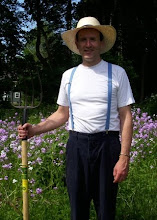I did the major harvest and planting that I spoke about in the last post a week later than planned (just this past weekend). I harvested about 10 thin stemmed bunches of celery, 4 bunches of parsley, a cabbage (~4" diameter) and a couple of pounds of carrots. Many cabbage worms were fed to my koi that day.
After digging in the soil to plant the kale, choi and lettuce that have been growing under lights in the basement (way too long, btw) , I am convinced that the major factor contributing to poor growth of some plants this year is the infiltration of roots from the nearby silver maple into the growing beds. I am finding a dense network of very strong roots throughout many of the raised garden beds, some approaching a half-inch in diameter. This explains why the beds have been so thirsty this year.
After doing some research to see how others have dealt with the problem, I have decided on a new design for my raised beds. I am going to raise the beds up on an extra course of 2'x8' filled in with stone (preferably granite). In order to prevent tree roots from finding their way up into these planters (in case the gravel barrier is not enough), I will place a sheet of galvanized metal between the ground and the planter. It looks like the cost will be $31 in #2 gravel per 96"x 30" bed and $38 for four 2" x 8" x 12' fir to build the boxes. The galvanized metal is $16 per 20" x 10' roll. I will be able to use soil from the existing frames, so no extra cost there.
Altogether, the cost will be about $100 per bed and I will need to build six beds to slightly exceed the current area of my seven 4' square beds. It sounds like a large investment, but the ROI will be maybe two years and I plan to continue gardening for many more years than that, not to mention the enjoyment that I receive from working in the garden and the superior quality of vegetables obtained.
As indicated above, I am also planning to adopt the 30" wide bed recommendation of Eliot Coleman versus the 4' square gardens that I have been building for more than thirty years. The narrower beds will be easier to plant and maintain.
Apart from the idea of starting from the beginning with a perfect soil mix, this change will be a major break from "square-foot gardening" as a practice. I had already abandoned the idea of planting only within squares a couple of years ago realizing that I can locate plants more efficiently and creatively without that constraint.
Interestingly, I have not had a problem with blossom end rot for a while. The first four green peppers and the first several beefsteak tomatoes had it, but now all of the fruit appears healthy. Perhaps it just took a while for the calcium from the eggshells that I added to the soil this spring to become available. The only problem now is that the squirrels seem to be getting to the tomatoes before I can. I have never had a problem with squirrels eating my tomatoes before. A friend tells me that it is a problem this year because of the severe drought that we have experienced. The squirrels and other urban denizens are accessing sources of food that they would normally leave alone. They have also been attacking my acorn squash plants, both fruit and stem have been gnawed.
I have saved over $400 in veggie purchases by having the garden this year, but I know I will do even better next year once the tree roots are banished from the garden beds. I will be trying some new irrigation emitter designs as well as building the first raised planter in the coming weeks.
Tuesday, August 30, 2016
Subscribe to:
Post Comments (Atom)


No comments:
Post a Comment